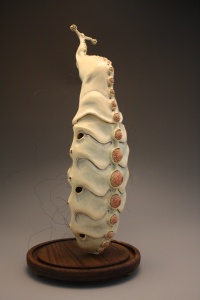By Amanda Lehnerd
Q1: Who are you as an artist?
I am a studio artist and educator. I am currently an assistant professor of fine art and chair of the Fine and Performing Arts Department at Indiana University East. I hold a BA in Studio Art from Wittenberg University and a MFA from Indiana University in Bloomington, Indiana. My teaching and art making go hand in hand, my students motivate me to continue to stay connected in the field and fearlessly experiment with creative expression. 
Q2: How did you get started in ceramics?
I met clay my sophomore year of college in a 3-D design course. I was immediately hooked. Thankfully, I had a wonderful professor that saw my potential and encouraged me to pursue an art major.
Q3: Did you always want to study and work with ceramics?
No. Until my sophomore year of college, I had no clue what I wanted to study or what career I wanted to pursue. I grew up in a family of artists, but never considered myself one. I never considered working with clay until I had a clay assignment for a course. I value all forms of expression. I think clay is just another tool/material like any other to use for visual expression and it just happens to have a diverse/amazing history. Even though I’m primarily a sculptor who happens to work with clay, I proudly identify myself as a ceramicist. The material continues to inspire and amaze me.
Q4: How does your artwork investigate the relationship between the art object and a scientific specimen?
My inspiration comes from nature (pregnancy, childbirth, fossils, insects, plants, etc.). My sculptures are displayed like scientific specimens, under glass bell jars to encourage the viewer to more closely observe the art piece and question its authenticity. Over the past year, I’ve been serving as a visiting artist in collaboration with Katy Börner, professor of Information Science at IU Bloomington. This collaboration is part of the “Places & Spaces: Mapping Science Exhibition”. Using the purpose of this exhibition as a starting point, I have experimented with clay and wire to create 3-D prototypes representing the growth and intersections of distant fields of knowledge. As an artist, this project has inspired me to more carefully consider the meaning of form, surface and color relationships as they are tied directly to specific information.
Q5: What will you be talking about during your workshop?
I will demonstrate how I use china paints to heighten the dimension of my sculptures and create a more believable organic surface. Then, I will invite participants to experiment with a variety of water based mediums to apply china paints. Participants can china paint on glazed tiles (provided) or bring in their own glazed ware. Mediums include: glycerin, artificial sweetener, MiraLax, gum arabic, glue and milk. Each of these materials has a completely different effect with the china paint, some dry quickly and are great for detailed linear work, others stay “open” and are great for gradients and blends.
